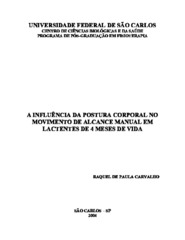| dc.contributor.author | Carvalho, Raquel de Paula | |
| dc.date.accessioned | 2016-06-02T20:19:08Z | |
| dc.date.available | 2004-10-07 | |
| dc.date.available | 2016-06-02T20:19:08Z | |
| dc.date.issued | 2004-03-10 | |
| dc.identifier.citation | CARVALHO, Raquel de Paula. The influence of body posture in manual reaching on 4-month-old infants. 2004. 132 f. Dissertação (Mestrado em Ciências Biológicas) - Universidade Federal de São Carlos, São carlos, 2004. | por |
| dc.identifier.uri | https://repositorio.ufscar.br/handle/ufscar/5231 | |
| dc.description.abstract | The aim of this work was to investigate the influence of body posture during reaching
movements in four healthy, four-month-old infants. Experimental conditions consisted of
presenting two toys alternately, at the infant s midline and shoulder levels and midway between the infant s shoulder and wrist. After the reaching, the toy was taken away and given back again for a period of two minutes (for each toy) or until the infant reached for it a total of ten times. This procedure was repeated at the supine posture (0º), a reclined posture (45º) and a sitting posture (70º). We randomized this order these positions. The results were recorded on video and analyzed using the Dvideow system for the purpose of checking the kinematics of the angle of the shoulder (flexion/extension and
abduction/aduction) and elbow flexion/extension). Also, we analyzed the rectitude index (the distance traveled by the hand during a reaching movement divided by the distance between the starting and the end points), time (in seconds) in each of the three positions, as well as the frequency of reaching unimanually and bimanually. The statistical method used for the rectitude index was t-Student test and for the frequency of reaching was the analysis of variance (ANOVA). From the results showed that there were differences between the frequency of reaching unimanually and bimanually (p-value=0,0341) in sitting posture. The frequency of reaching was more in sitting posture than in supine posture. In relation to the rectitude index, the test showed a significant difference between the supine and reclined postures (p-value=0,001) and the supine and sitting postures (p-value=0,001). The infants
spent the same time reaching in the tree postures. When analyzing the angles, only two
babies used the same movement pattern for the three positions. We concluded that, the age
of 4 months, reaching does not follow a stable pattern, which can be modified by the position of the infant. Each infant has its own intrinsic dynamics and reacts in different ways to the environmental restrictions imposed by different body positions. | eng |
| dc.description.sponsorship | Financiadora de Estudos e Projetos | |
| dc.format | application/pdf | por |
| dc.language | por | por |
| dc.publisher | Universidade Federal de São Carlos | por |
| dc.rights | Acesso Aberto | por |
| dc.subject | Terapia pediátrica | por |
| dc.subject | Biomecânica | por |
| dc.subject | Análise cinemática | por |
| dc.subject | Desenvolvimento motor | por |
| dc.subject | Lactente | por |
| dc.subject | Biomechanics | eng |
| dc.subject | Kinematic analysis | eng |
| dc.subject | Upper limbs | eng |
| dc.subject | Infants | eng |
| dc.title | A influência da postura corporal no movimento de alcance manual em lactentes de 4 meses de vida. | por |
| dc.title.alternative | The influence of body posture in manual reaching on 4-month-old infants | eng |
| dc.type | Dissertação | por |
| dc.contributor.advisor1 | Tudella, Eloisa | |
| dc.contributor.advisor1Lattes | http://lattes.cnpq.br/3207258034860219 | por |
| dc.description.resumo | O presente estudo teve como objetivo investigar a influência da postura corporal na execução do movimento de alcance em quatro lactentes a termo, saudáveis, com idade de 4 meses de vida. A condição experimental consistia na apresentação de dois brinquedos, alternadamente, na altura dos ombros dos lactentes. Após o alcance, o brinquedo era retirado e apresentado novamente, durante um período de dois minutos para cada brinquedo
ou até que o lactente realizasse 10 alcances. Este procedimento foi repetido nas posturas supina (0º), reclinada (45º) e sentada (70º), sendo a ordem escolhida de forma aleatória. As avaliações foram filmadas e analisadas pelo sistema Dvideow, com objetivo de verificar o comportamento das variáveis cinemáticas de ângulo de ombro (flexão/extensão e
abdução/adução) e cotovelo (flexão/extensão), índice de retidão (distância percorrida pela
mão durante o alcance dividido pela distância entre os pontos de início e fim) e tempo (segundos) em cada uma das três posições, além da freqüência de alcances unimanuais e bimanuais. O método estatístico empregado para o índice de retidão foi o teste t-Student e para a freqüência de alcances, a análise por variância (ANOVA). A partir dos resultados obtidos constatamos que houve diferença entre a freqüência de alcances unimanuais e bimanuais (p=0,0341) na postura sentada. A freqüência de alcances na postura sentada foi maior que na supina (p=0,038). Em relação ao índice de retidão, o teste indicou diferença significativa entre as posturas supina e reclinada (p=0,001) e entre supina e sentada
(p=0,002). Os lactentes gastaram o mesmo tempo no alcance nas 3 posturas. Na análise dos
ângulos, apenas dois lactentes usaram o mesmo padrão motor para as três posições. Baseando-se na abordagem dos sistemas dinâmicos, verificamos que o alcance ainda é um padrão instável de comportamento, o qual pode ser modificado pela posição do lactente. Cada lactente possui uma dinâmica intrínseca e responde de maneiras diferentes à restrição do ambiente imposta por meio das diferentes posições do corpo. | por |
| dc.publisher.country | BR | por |
| dc.publisher.initials | UFSCar | por |
| dc.publisher.program | Programa de Pós-Graduação em Fisioterapia - PPGFt | por |
| dc.subject.cnpq | CIENCIAS DA SAUDE::FISIOTERAPIA E TERAPIA OCUPACIONAL | por |
| dc.contributor.authorlattes | http://genos.cnpq.br:12010/dwlattes/owa/prc_imp_cv_int?f_cod=K4762430J4 | por |
